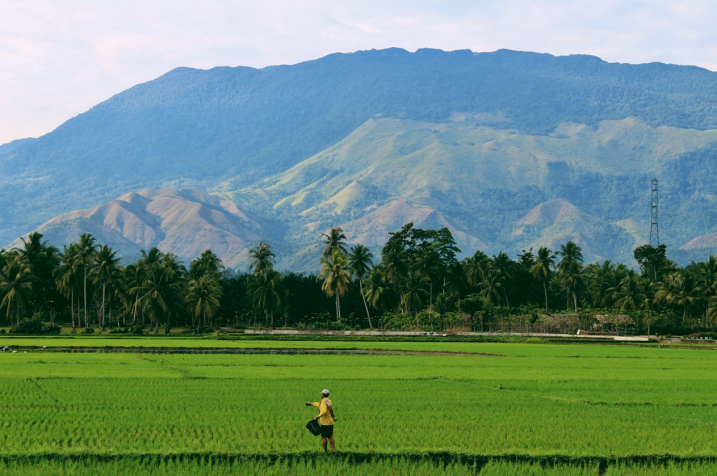
Frontier Technology Issues: Frontier technologies for smallholder farmers: addressing information asymmetries and deficiencies
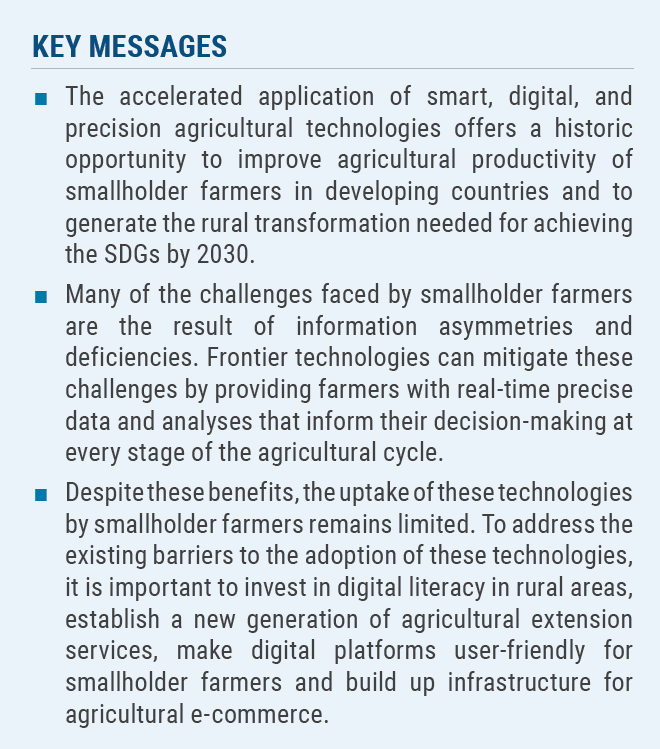 Introduction
Introduction
While fertilizers, genetically modified crops, and biotechnology have brought substantial benefits for farmers in recent decades, the accelerated application of smart, digital, and precision agricultural technologies offers a historic opportunity to improve farm productivity going forward. Such technologies are wide-ranging, including small mobile applications for decision support, field sensors and remote sensing technologies for data collection, drones and robots for automation of processes, and digital platforms for market access and sales. Use of these technologies helps address information asymmetries and deficiencies facing farmers, particularly smallholders, which can improve agricultural productivity and save costs, while also helping to mitigate the environmental impact of farm activities.
The application of smart, digital, and precision technologies has already had significant impact on farming worldwide, primarily in large-scale farming in high-income countries. But there are enormous opportunities for the greater application of such technologies by smallholder farmers, including in low-income countries. More than 80 per cent of the world’s half a billion farms operate on less than two hectares of land. Although these farms account for only 12 per cent of all farmland, they provide an estimated 80 per cent of the food produced in Asia and sub-Saharan Africa (Lowder and others, 2014).1 The enhanced application of smart, digital, and precision technologies is critical for raising the agricultural productivity of smallholder farmers in developing countries and generating the rural transformation needed for achieving the SDGs by 2030.
This Frontier Technology Issue (FTI) focuses on a select set of technologies that address informational challenges that farmers face and that have the potential to create high economic value for smallholder farms in developing countries. The FTI highlights the benefits of these technologies, the barriers to their adoption, as well as the factors that may enable their implementation.
Frontier technologies can reduce information asymmetries throughout the agricultural cycle
Smallholder farmers face challenges throughout the agricultural cycle, from crop planning and purchase of inputs to harvesting, processing, and sale of their products. Many of these challenges stem from insufficient information. For example, smallholder farmers’ access to better credit facilities can be hindered by financial illiteracy and the inability to provide the necessary information to financial institutions for credit analysis and loan appraisal. Throughout the agricultural cycle, smallholder farmers also face particular challenges in accessing information about weather and climate, knowledge on plot-specific inputs and planting techniques, and data about markets, which would allow them to establish stronger and more direct links to consumers. Frontier technologies can play a role in mitigating these information asymmetries by providing real-time and precise data that inform smallholder farmers in their decision-making at every stage of the agricultural cycle (figure 1).
The subsequent sections focus on the use of frontier technologies in three key stages of the agricultural cycle.
◆ The preparatory stage (crop planning, purchase of inputs, and soil preparation) is critical for the overall value of the agricultural output of smallholder farmers. It is during this stage that smallholder farmers decide what, when, where, and which plants to grow considering the requirements for space, sunshine, water, and other factors.
◆ The production stage (planting, monitoring, and harvesting) involves the use of resources such as soil, water, and energy. The objective is to enable smallholder farmers to engage in specialized production at a higher level of productivity to save both financial and natural resources. Smallholder farmers must take a long-term view when making decisions on resource use to generate sufficient profits so as to earn a living. They must also be aware of possible trends in climatic conditions and learn how to adapt their production methods accordingly.
◆ The processing and sale stage is critical for farmer incomes by bringing agricultural production in rural areas closer to urban and global consumers. Being able to integrate production into fully formed agricultural value chains means that smallholder farmers can take advantage of new market opportunities and sell their agricultural products to an increasingly urban consumer base. It also encourages investments to enhance farm productivity.
Below we take a deeper dive into a select set of technologies at these three stages of the agricultural cycle and their development implications for smallholder farms.
Frontier technologies for improving smallholder farmers’ seed selection
Seed selection is one of the most consequential decisions that farmers have to make in the agriculture cycle. Farmers need to consider several factors when selecting seed varieties that match the specific conditions and management practices of their operations, including seed cost, crop prices, yield potential, crop resistance to disease and pest, soil profile, weather, and duration of the growing season, among others.
Effective seed selection requires the collection of accurate site-specific and other reference data, as well as analytical models – developed by researchers – that can turn such information into actionable insights that are made accessible for smallholder farmers. Much of the data can be collected through sensors that monitor the state of the soil, water, light, humidity, and temperature. Unmanned aerial vehicles, commonly known as drones, have become a powerful technology that can be used together with a global positioning system and other sensors to collect precise local data. Equipped with multispectral, visual, and thermal sensors that use different wavebands to capture both visible and invisible images of crops and vegetation, aerial drones are used to collect data such as moisture content in the soil, plant health, and stress levels, etc. (Sylvester, 2018).
Drones complement satellites as the latter tend to have a coarse spatial resolution that typically ranges from tens of metres to kilometres, which is not always useful for smallholder farmers (Cucho-Padin and others, 2020). Advances in satellite technologies have allowed spatial resolution down to a few metres or even sub-metre, but the associated cost is exorbitantly high and therefore not realistic for smallholder farmers. Another limitation of satellite technology is the large distance between the satellite and the ground, which means that signals can be affected by a host of factors – from water vapor to clouds – potentially compromising data quality. A recent study (Benos and others, 2021) shows that there was a rapid increase in the use of drones in 2018–2020, reflecting the fact that they produce fast and economical results. In India, aerial drones with long-range, high endurance, and payload capacity are employed to acquire multispectral data for soil mapping and crop health monitoring, which deliver actionable insights to farmers’ handheld devices (Sylvester, 2018).
Translating data into development outcomes
The large amount of data collected through a network of sensors is only useful if properly processed and if the data generates insights that are communicated clearly to smallholder farmers. A key piece of insight to be derived from this data is predicted crop yield, which can be estimated by models that employ machine learning techniques. The Artificial Neural Network models appear to be the most popular among the many machine learning methods developed by researchers for crop yield prediction and they have demonstrated superior results (Benos and others, 2021). The Artificial Neural Network models have several advantages, including the ability to detect relationships – including complex, non-linear ones – between dependent and independent variables and to handle “noisy” data, with the latter being very common in agricultural measurements (Benos and others, 2021).
An example of machine learning used to inform seed selection can be found in Mexico, where data from on-farm and experimental sites and seed companies are used to develop models that predict how different seed varieties perform in particular conditions and advise farmers what maize to plant. A pilot project demonstrated that the application of machine learning can increase yields and reduce crop production costs, thereby improving overall economic efficiency by more than 25 per cent (CGIAR Platform for Big Data in Agriculture, 2019). These models have also the potential to be used by smaller seed companies to ensure that they sell the best variety possible for a particular region, which could, in turn, reduce the farmers’ risk of planting seeds that are not suitable for specific geographic conditions.
Another example is an EU-funded initiative that develops an online platform that uses AI algorithms to help farmers in Europe select seeds based on GIS, environmental, and disease resistance- related data, along with the farmer’s means of production and information on market needs (European Commission, 2019). A feasibility study carried out under this initiative shows that there is significant demand for this type of platform in Europe. By supporting farmers to select seeds and other agricultural inputs best suited for their plots of land, such platforms help to increase yield and quality, while reducing chemical use that has adverse environmental effects.
Frontier technologies for planting, growing, monitoring, and harvesting crops
Fertilizer application, selection of irrigation regimes, and deciding when to harvest can be challenging for smallholder farmers. Crop management has traditionally been based on farmers going to the fields to check the status of their crops and make decisions based on a visual inspection. Frontier technology can offer a more systematic tool to detect unanticipated patterns and problems, which are often difficult to observe by visual inspection. Also, despite knowing that there are variations within a field due to differences in soil, slope, and shade, many farmers do not have adequate information and knowledge to adopt more precise farming techniques. As a result, many farmers follow general prescriptions for irrigation, fertilizers, and pest control, which often lead to overuse and increased costs.
For smallholder farmers to adopt more precise farming methods, they need better information on the temporal and spatial variability of environmental parameters, including their impact on soil, crop, pests, diseases, and other components of farming. Basic sensors can be used on the farm to give information about soil properties, temperature, and weather, but more advanced sensors are being developed that monitor air and water quality, soil pH, plant health, and product ripeness. These sensors are accompanied by software for predictive analysis, calibrated for specific crops or varieties and regions, which can allow the farmer to customize decisions per square metre of the farm or even down to each plant. Concretely, this can help in terms of: (a) cropping: when to sow the seed based on the type of crop and predicted weather; (b) management: when to irrigate, fertilize and apply pesticide; and (c) harvesting: when to harvest the crop based on market prices, predicted weather and storage cost. This can give farmers the necessary information for more informed agricultural management and has the potential to increase profit by increasing yields and reducing input costs (Saiz-Rubio and Rovira-Más, 2020).
These technologies, while beneficial for yields and profits, can also contribute to a shift towards more sustainable agriculture and greater protection of biodiversity and wildlife by cutting soil, water, and air pollution, by diminishing the use of fertilizers, pesticides and water, and by reducing carbon emissions from the farming sector. While some have the impression that organic farming and new technologies are mutually exclusive, frontier technology, such as small sensors, can play an important role in promoting the shift to circular and organic agriculture.
In addition, these sensor networks can play an important role in reducing food waste and loss along the supply chain post-harvest. Around 14 per cent of the world’s food is lost between harvest and delivery to shops and markets. Sensors can monitor temperatures during transit, and if fresh produce exceeds a temperature threshold during transit, this could be captured in real-time. Also, there is an increased demand to learn where food comes from, and stricter non-tariff regulations pertaining to trade in food products. There are concerns that these traceability requirements and sanitary and phytosanitary issues will constrain exports of food products from smallholder farmers in developing countries. Sensors could reduce this constraint by automatically collecting and sharing such information from smallholder farmers with distributors and retailers to meet these requirements. For many years, sensor technology was mainly considered appropriate for industrialized farms in high-income countries and not relevant for small-scale farmers in developing countries.
However, a growing body of research now demonstrates the benefits of sensor technologies for small-scale farmers for different reasons (Dargie and Zimmerling, 2007). First, they can operate independently of any electrical network, as they can be energised by battery or solar power, and the technology functions well in areas with low bandwidth (FAO, 2020). Second, the ability to collect these types of data in real-time enables more efficient irrigation, which is especially important for smallholder farmers in semi-arid areas of developing countries. Third, while it was initially considered relevant for large farms with significant spatial variability in terms of soil conditions, recent evidence shows even in the smallest plot of land, there is often large spatial variability, justifying this type of technology even for smaller farms (Cao and others, 2012).
A recent feasibility study has demonstrated how low energy consumption and low-cost wireless sensor networks can be a viable option for monitoring environmental, soil, and crop parameters, even in isolated rural areas. This type of wireless sensor network uses a dummy device as a coordinator which receives, processes, and sends data packets from all end-nodes to the cloud via a cellular network. Furthermore, it is energy independent, making use of solar energy, which enables it to operate in remote fields (Tagarakis and others, 2021) (figure 2).
There is an increasing number of successful projects applying this technology in developing countries. A pilot project in Bangladesh has demonstrated the potential of sensor technology to boost agriculture production. In this project, to overcome technological and language barriers, sensors transmitted information to a local university, where researchers analyse data and send crop management information to the farmers’ devices in the local language (CRI, 2017). In Colombia, sensor technology has been adopted to monitor plantain crops in the Santa Rosa de Cabal region, helping to improve information about harvesting projections, optimize water usage, and prevent plagues and diseases. This type of technology has also been used in aquaculture in Viet Nam, where a wireless sensor network monitors water quality in fish farms, with a positive impact on both the quality and quantity of production (Libelium, 2021).
Frontier technologies to facilitate greater access to markets
Digital platforms, particularly those that leverage mobile devices, greatly expand the reach of agricultural services and information to even the most remote rural areas. Mobile technologies are increasingly used throughout the agricultural production cycle, helping to disseminate valuable information to farmers on the selection of inputs and seeds, on weather, pests, and diseases, and on market and price conditions, as discussed earlier (figure 3). Digital technologies that improve farmer access to capital and information assets eases, for example, the procurement of inputs during the initial phase of the agricultural cycle. Digital technologies also help farmers better access services and facilitate crop planning and monitoring. Finally, digital e-commerce platforms that improve access to markets can help farmers access inputs and services, but principally help with the final stage of commercialization. As it has done in other sectors, agricultural e-commerce addresses notable challenges and inefficiencies in supply chains, building and strengthening links along the entire food production value chain. Many agricultural e-commerce services have been launched across developing countries, some focused on markets for agricultural inputs while others designed to help farmers bypass intermediaries and sell directly to agri-businesses (processors, wholesalers, etc.), retailers, and consumers.
E-commerce can help farmers increase their income by making market prices more transparent and reducing their dependence on intermediaries that sell their products (box 1). E-commerce platforms for agricultural products can also help reduce wastage in food supply chains. Farmers can use the price transparency of digital platforms to find buyers and reduce the risk of post-harvest losses. E-commerce and associated digital payments also help farmers build a digital history of their business transactions and demonstrate creditworthiness to financial service providers. This helps them access financial services, including innovative financial products such as microcredit and crowdfunding platforms. Finally, the uptake of e-commerce by smallholder farmers increases the demand for the platforms themselves and the ecosystem of associated services such as transportation and finance. The greater provision of support services allows e-commerce platforms to further expand and reach more agricultural producers.
 There are numerous examples of the successful deployment of e-commerce platforms for agriculture. In India, a study by the International Maize and Wheat Improvement Centre in 2011 found that about 71 per cent of smallholder farmers who use mobile phones for price and market information reported having obtained a better price for their products (Mittal and Mehar, 2012). Farmers in Mozambique that use IzyShop, an e-commerce platform, also reported monthly revenues five times larger than the country’s average for smallholder farmers (Joiner and Okeleke, 2019). In Colombia, farmers selling fruit and vegetables through the e-commerce platform Frubana reported post-harvest losses of just 3 per cent, compared with the average of 58 per cent for farmers that sell through traditional channels (Joiner and Okeleke, 2019). In Kenya, the B2B e-commerce firm Sokowatch connects merchants with local and international suppliers. The company’s e-commerce platform enables shopkeepers to order products (via SMS or mobile app) directly from suppliers, often with same-day delivery. The company also provides shopkeepers with inventory credit and advice on which products to sell to maximize earnings (Zafar, 2020).
There are numerous examples of the successful deployment of e-commerce platforms for agriculture. In India, a study by the International Maize and Wheat Improvement Centre in 2011 found that about 71 per cent of smallholder farmers who use mobile phones for price and market information reported having obtained a better price for their products (Mittal and Mehar, 2012). Farmers in Mozambique that use IzyShop, an e-commerce platform, also reported monthly revenues five times larger than the country’s average for smallholder farmers (Joiner and Okeleke, 2019). In Colombia, farmers selling fruit and vegetables through the e-commerce platform Frubana reported post-harvest losses of just 3 per cent, compared with the average of 58 per cent for farmers that sell through traditional channels (Joiner and Okeleke, 2019). In Kenya, the B2B e-commerce firm Sokowatch connects merchants with local and international suppliers. The company’s e-commerce platform enables shopkeepers to order products (via SMS or mobile app) directly from suppliers, often with same-day delivery. The company also provides shopkeepers with inventory credit and advice on which products to sell to maximize earnings (Zafar, 2020).
The COVID-19 pandemic has also created new difficulties for smallholder agriculture in remote regions. In Africa, for instance, countries restricted formal and informal cross-border trade movement and lockdown measures have disrupted transport, logistics, processing and retail operations that comprise the local food value chain. Among the many interventions needed to support vulnerable farmers, agricultural e-commerce can address some needs by helping to build better aggregation and transportation services in the production chain, and by helping to link smallholder farmers with food vendors and food processors (Hambloch, Tui and Ojiewo, 2020).
Barriers and enablers for technology adoption by smallholder farms
Despite the significant benefits that increased application of digital technologies can generate for smallholder farmers in rural areas of developing countries, their uptake remains limited because of the existence of barriers such as lack of digital literacy and trust, gender gaps, limited availability and high cost of services and devices, insufficient access to credit, uncertain return to investment in new technologies, and behavioral inertia.
The explosive growth in the availability of data – a product of technological advances, including those discussed in this report – means that smallholder farmers in developing countries must also manage many different sources of information in order to fully realize the potential gains that data analytics offer. However, specialized technical knowledge is often required to make sense of the many data models, formats, interfaces, and reference systems used in the digitalized agricultural cycle, while such knowledge is difficult for smallholder farmers to obtain.
Another barrier for the adoption of digital technologies is that agricultural products in domestic markets are generally not standardized by size, age, and quality, and consumers often prefer to shop for fruits and vegetables in person. The e-commerce of perishable agricultural products also often faces considerable logistical challenges to ensure freshness and safety. Furthermore, smallholder farmers in developing countries, particularly in low-income regions, live in areas where the physical infrastructure needed for efficient commercialization (roads, warehouses, transport systems, etc.) is either lacking or non-existent, and where the access to digital connectivity is still limited. In addition, there are often well-entrenched intermediaries in the food production chain, especially in developing countries, resistant to technological disruption to their market position.
To address these barriers, it is important to undertake steps such as the following:
Invest in digital literacy in rural areas
Increasing digital literacy and reducing the technological divide by improving education and access to other services are critical steps towards greater application of the new digital technologies by smallholder farmers. The COVID-19 pandemic and the social distancing measures implemented to curb the spread of the disease, which resulted in millions of people modifying their daily habits, as well as an urgent need to digitalize work, education and trade, have rendered this inclusion in rural areas all the more urgent. Improving digital literacy could also be a decisive factor in improving crop and animal production, and in turn, the income of smallholder farmers in developing countries, and thus promote rural retention. This could also include a more concerted effort to equip both local seed traders and farmers with the knowledge and skills to access available seed information systems.
Establish a new generation of agricultural extension services
During the Green Revolution, agricultural extension services played an important role in enabling smallholder farmers in developing countries to take advantage of new seed varieties. A new generation of extension services is now needed to accelerate the adoption of digital technologies by smallholder farmers, particularly in developing countries. The new model should also ideally address the inadequate integration that often exists between extension services and research because of their organization in different administrative units. A rethinking of the current model of extension services is thus required to address the new and growing challenges posed by the demands of agricultural markets and technology as well as the goal of sustainable development. Extension services increasingly need to focus on developing agricultural innovation systems that enable smallholder farmers to participate in the introduction of technologies such as those discussed in this Frontier Technology Issue. For example, the heavy lifting in developing analytical models to process the massive amount of data generated in the digitalized agricultural cycle would most likely be carried out by governments, private sectors, academia or farmers’ associations, but smallholder farmers must have a voice in shaping the development of these models if they are to be effective at contributing to sustainable rural transformation.
Make digital platforms user-friendly for smallholder farmers
The massive amount of data generated by the new digital technologies can easily create an informational overload for smallholder farmers. Mitigating this challenge could, for example, take the form of a digital platform that allows farmers to access information on different seed varieties in one centralized depository. The International Crops Research Institute for the Semi-Arid Tropics has taken a step in this direction by developing an online seed catalogue that enables governments, small-scale seed producers as well as private companies to plan, produce, monitor, and provide quality seeds to smallholder farmers. The platform is now serving farmers in seven sub-Saharan African countries, and India.
Build up infrastructure to promote agricultural e-commerce
A few enablers have been shown to be particularly effective in increasing the uptake and impact of agricultural e-commerce. One is the degree of farmer preparedness to participate in e-commerce. The availability of mobile devices to keep producers and workers connected and to ensure that products are tracked and managed is another enabling factor. It is also important that farmers understand how to meet quality standards set by an e-commerce platform.
The degree of experience of buyers with e-commerce can, for example, foster greater trust and appreciation of the benefits of buying products online. The expansion of available rural infrastructure in the form of roads, electricity, internet connectivity to support logistic operations and services, as well as complementary legal, business and financial services, is also critical for the provision of effective e-commerce services. The costs associated with last-mile delivery, as an example, are often a major barrier to the expansion of e-commerce services in rural areas. Finally, the speed of e-commerce expansion also depends on the availability of digital payment solutions that reduce problems associated with using cash for commercial transactions (fraud, cost of collections, transaction fulfilment delays, etc.). This is particularly important in developing countries with low rates of debit and credit card penetration but is a key advantage to those that already have the wide acceptance of mobile money systems.

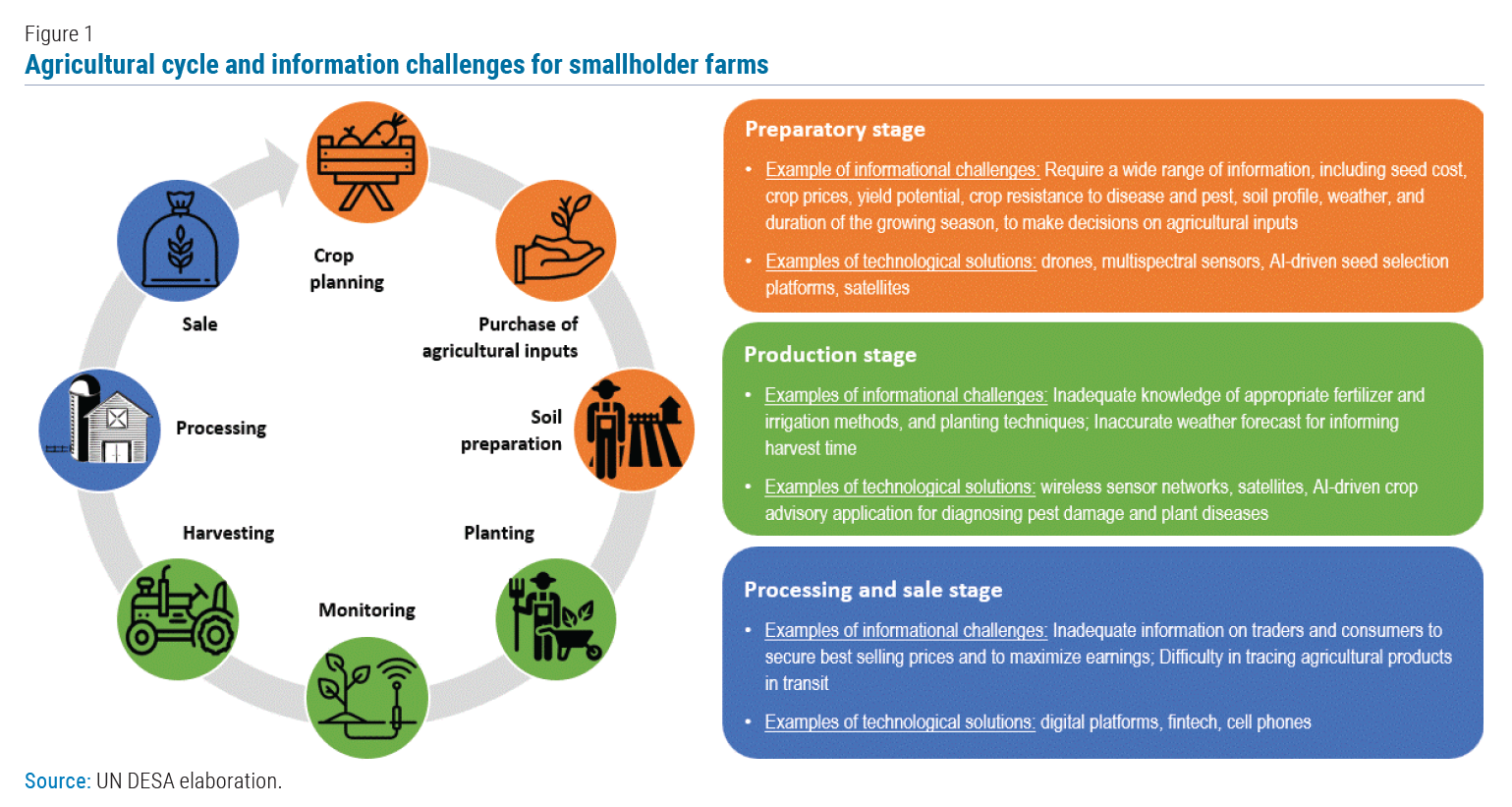
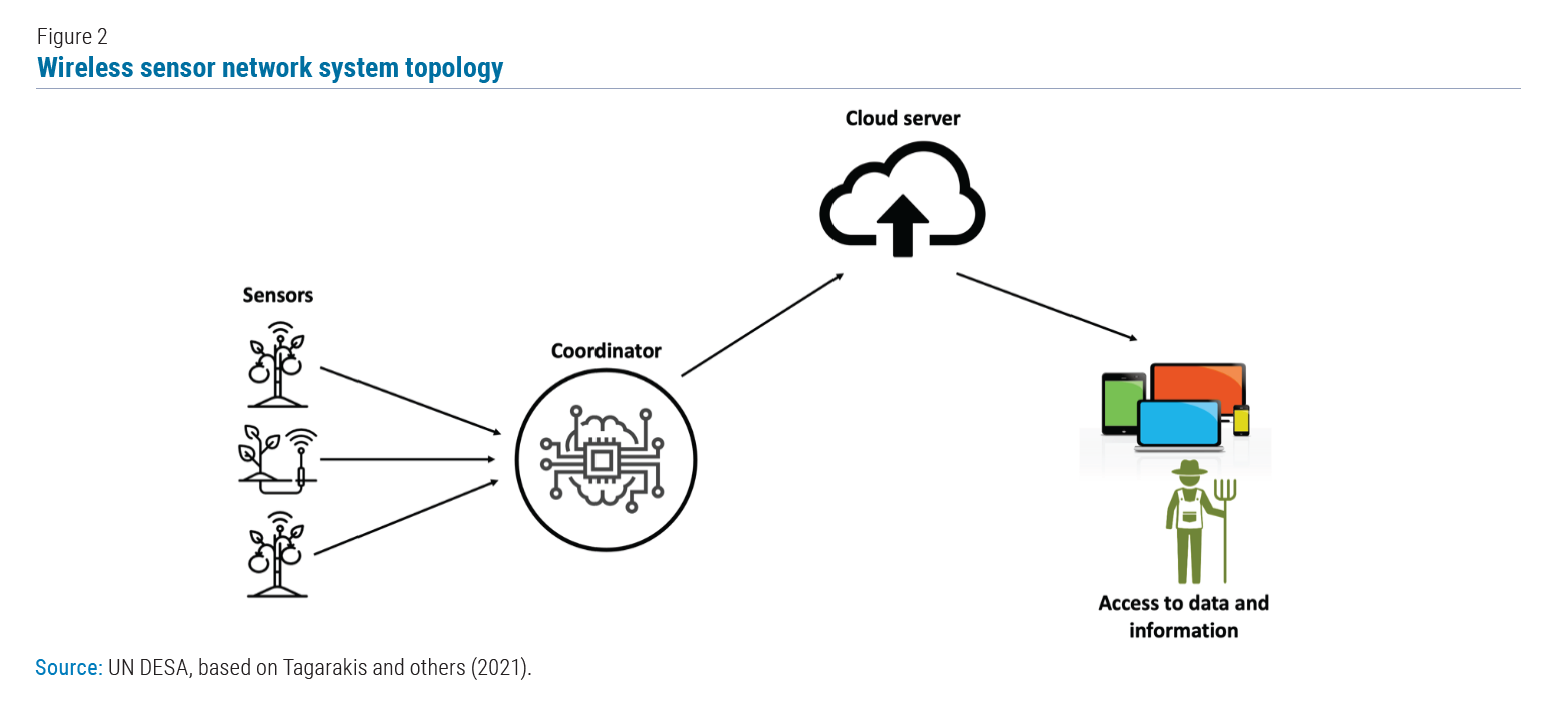
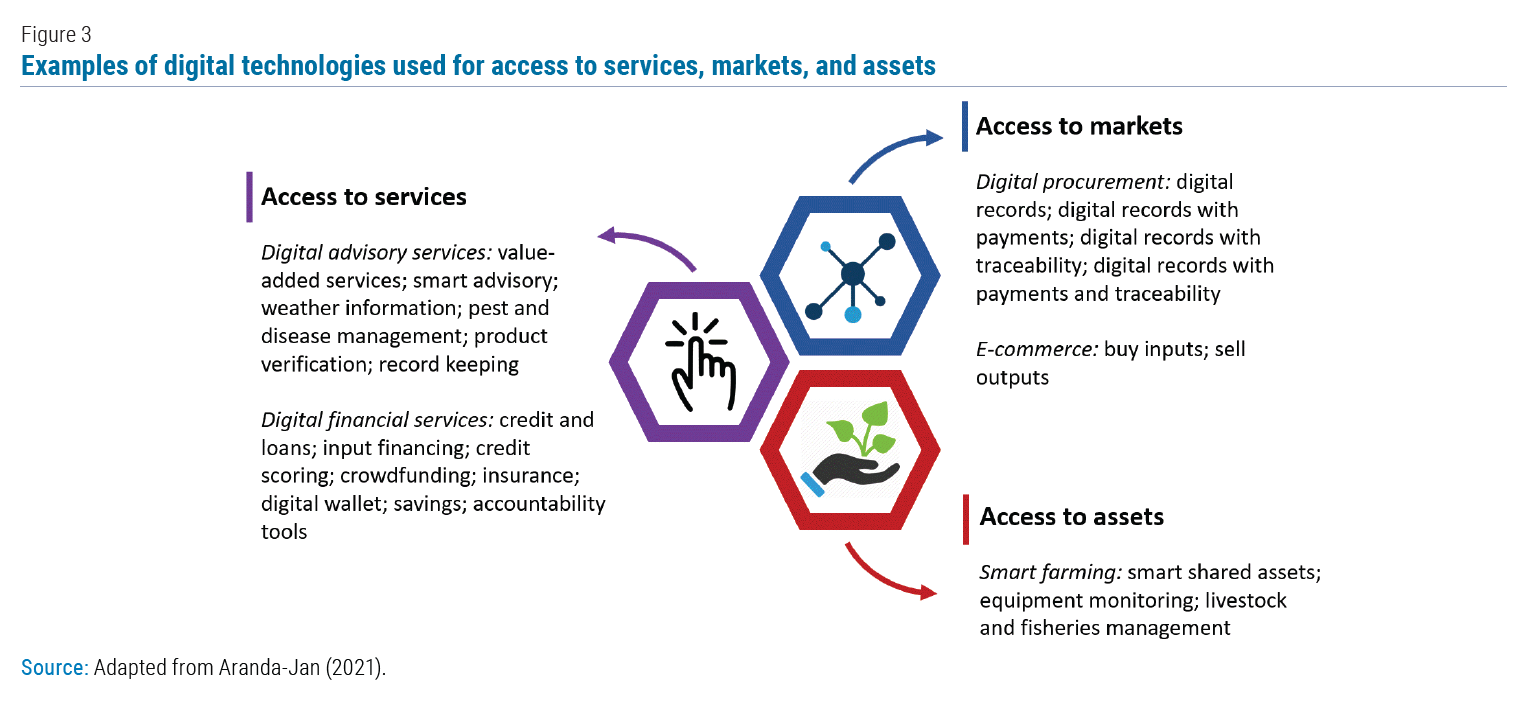
Follow Us